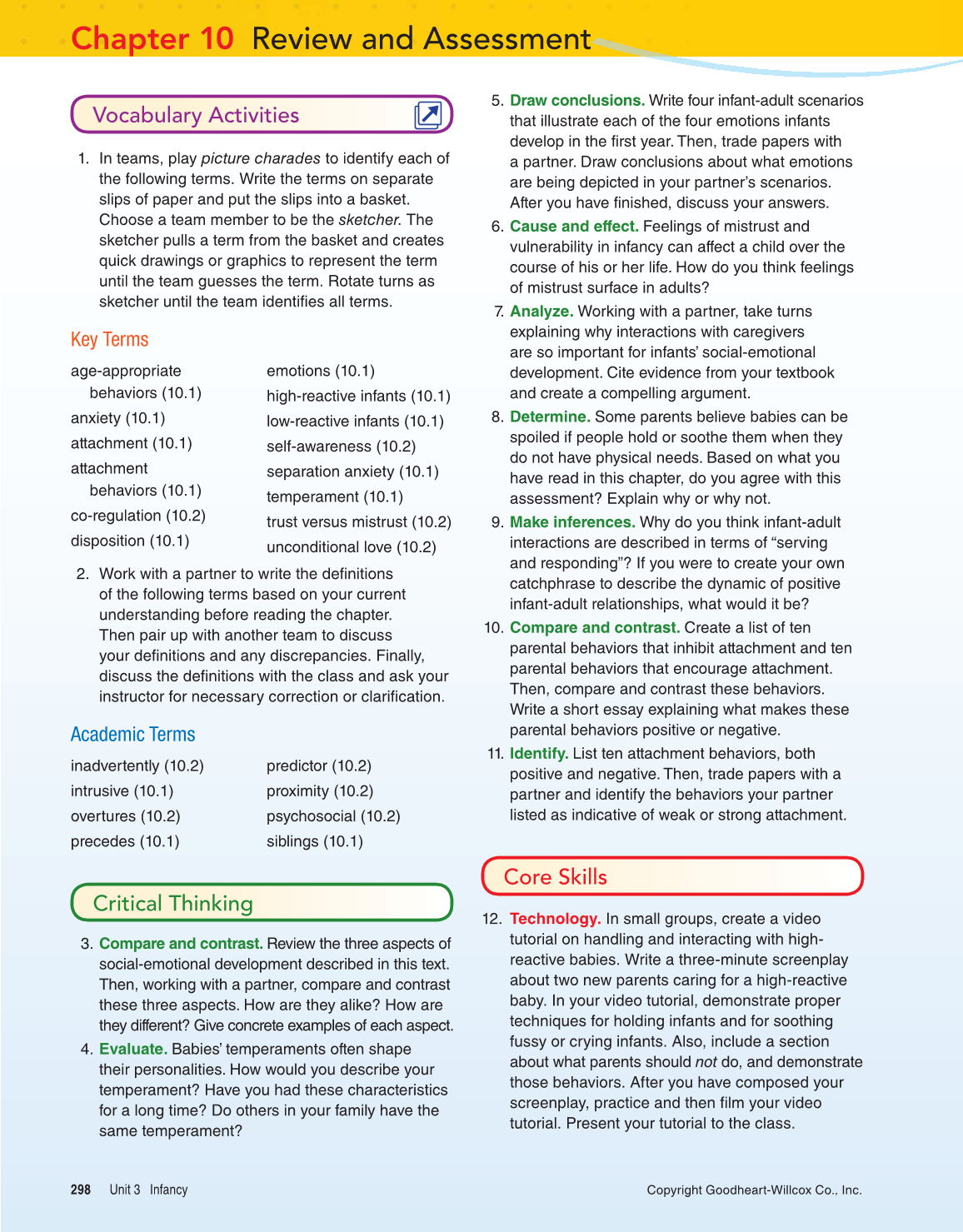298 Unit 3 Infancy
Copyright Goodheart-Willcox Co., Inc.
Chapter 10 Review and Assessment
Vocabulary Activities
1. In teams, play picture charades to identify each of
the following terms. Write the terms on separate
slips of paper and put the slips into a basket.
Choose a team member to be the sketcher. The
sketcher pulls a term from the basket and creates
quick drawings or graphics to represent the term
until the team guesses the term. Rotate turns as
sketcher until the team identifies all terms.
Key Terms
age-appropriate
behaviors (10.1)
anxiety (10.1)
attachment (10.1)
attachment
behaviors (10.1)
co-regulation (10.2)
disposition (10.1)
emotions (10.1)
high-reactive infants (10.1)
low-reactive infants (10.1)
self-awareness (10.2)
separation anxiety (10.1)
temperament (10.1)
trust versus mistrust (10.2)
unconditional love (10.2)
2. Work with a partner to write the definitions
of the following terms based on your current
understanding before reading the chapter.
Then pair up with another team to discuss
your definitions and any discrepancies. Finally,
discuss the definitions with the class and ask your
instructor for necessary correction or clarification.
Academic Terms
inadvertently (10.2)
intrusive (10.1)
overtures (10.2)
precedes (10.1)
predictor (10.2)
proximity (10.2)
psychosocial (10.2)
siblings (10.1)
Critical Thinking
3. Compare and contrast. Review the three aspects of
social-emotional development described in this text.
Then, working with a partner, compare and contrast
these three aspects. How are they alike? How are
they different? Give concrete examples of each aspect.
4. Evaluate. Babies’ temperaments often shape
their personalities. How would you describe your
temperament? Have you had these characteristics
for a long time? Do others in your family have the
same temperament?
5. Draw conclusions. Write four infant-adult scenarios
that illustrate each of the four emotions infants
develop in the first year. Then, trade papers with
a partner. Draw conclusions about what emotions
are being depicted in your partner’s scenarios.
After you have finished, discuss your answers.
6. Cause and effect. Feelings of mistrust and
vulnerability in infancy can affect a child over the
course of his or her life. How do you think feelings
of mistrust surface in adults?
7. Analyze. Working with a partner, take turns
explaining why interactions with caregivers
are so important for infants’ social-emotional
development. Cite evidence from your textbook
and create a compelling argument.
8. Determine. Some parents believe babies can be
spoiled if people hold or soothe them when they
do not have physical needs. Based on what you
have read in this chapter, do you agree with this
assessment? Explain why or why not.
9. Make inferences. Why do you think infant-adult
interactions are described in terms of “serving
and responding”? If you were to create your own
catchphrase to describe the dynamic of positive
infant-adult relationships, what would it be?
10. Compare and contrast. Create a list of ten
parental behaviors that inhibit attachment and ten
parental behaviors that encourage attachment.
Then, compare and contrast these behaviors.
Write a short essay explaining what makes these
parental behaviors positive or negative.
11. Identify. List ten attachment behaviors, both
positive and negative. Then, trade papers with a
partner and identify the behaviors your partner
listed as indicative of weak or strong attachment.
Core Skills
12. Technology. In small groups, create a video
tutorial on handling and interacting with high-
reactive babies. Write a three-minute screenplay
about two new parents caring for a high-reactive
baby. In your video tutorial, demonstrate proper
techniques for holding infants and for soothing
fussy or crying infants. Also, include a section
about what parents should not do, and demonstrate
those behaviors. After you have composed your
screenplay, practice and then film your video
tutorial. Present your tutorial to the class.
